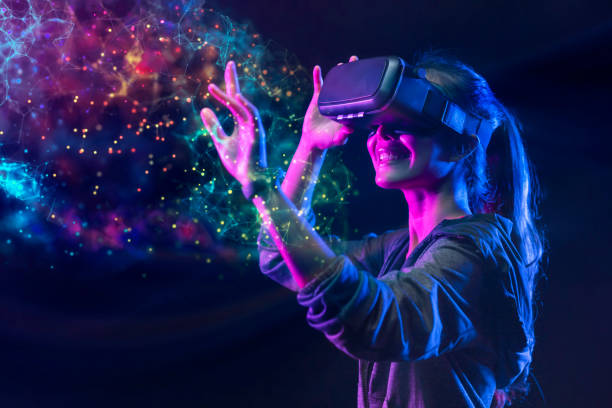AR and VR offer unique opportunities to enhance learning in classrooms. They enable students to explore historical landmarks, dissect virtual organisms, or practice surgeries.
However, educators must carefully consider how to implement these technologies in their lessons. They should ensure that each activity has a clear educational purpose and regularly evaluate students’ progress and understanding.
Benefits
Virtual reality is a powerful tool for learning, providing immersive digital experiences and interactive environments. It allows learners to practice skills in realistic simulations, improve retention, and increase engagement. It has been used in various industries for training purposes, including energy, manufacturing, automotive, healthcare, and aviation.
VR technology is also cost-effective. It eliminates the need for trainers to travel to sites, saving on expenses and time. Additionally, it provides a safer training environment, as learners can practice on equipment without the risk of damaging it or being injured. VR is also being used in the field of training for safety-critical industries, such as the oil and gas industry, where learners can train on equipment and perform virtual maintenance without putting themselves at risk.
AR and VR are being used to teach abstract topics that would be difficult for students to understand using traditional teaching methods, such as molecular structures or complex chemical compounds. For example, students can use AR to virtually visit historical monuments and museums, allowing them to experience history in a more immersive way than reading about it in books. In addition, students can use VR to learn a new language by immersing themselves in an unfamiliar culture and interacting with native speakers. They can even tour their future school in a virtual environment, eliminating stress and anxiety about transitioning to a new classroom.
Challenges
AR uses digital content to overlay information on the real world, while VR creates a virtual environment that immerses the user in a realistic experience. Both technologies have positive pedagogical effects and can enhance student engagement and performance, but it is important to consider their limitations before using them in a classroom setting. For example, integrating AR and VR in education requires teachers to have a deep understanding of the technology, which can be time-consuming and difficult for new teachers to master.
Another challenge is that AR and VR require a strong internet connection, which can cause lag or interruptions in the learning experience. To address this, educators can experiment with offline VR and AR experiences that can be pre-loaded on devices or stored locally, reducing the need for a stable internet connection.
Additionally, AR and VR can be difficult to use for students with visual or hearing impairments. Additionally, students with social or emotional disabilities may feel uncomfortable using these tools in the classroom.
In addition, VR can isolate learners and decrease interpersonal interaction between students. For this reason, it is important to use AR and VR in the classroom as a supplement to other learning tools.
Opportunities
AR and VR allow students to visualize complex ideas in a hands-on manner, encouraging them to make mental associations and connections with the subject matter. This helps with comprehension and knowledge retention, as students will have a solid base of understanding that they can build on for the rest of their lives.
These technologies also enable a deeper level of interactivity, which engages learners and makes learning more fun and effective. They bridge the gap between theoretical knowledge and practical application, allowing medical students to practice surgeries and engineering students to simulate construction projects. They also bring history lessons to life by transporting students on virtual field trips to famous monuments and events.
Moreover, VR enables immersive experiences that engage multiple senses, fostering a more holistic learning experience. For example, VR headsets can be used to display haptic feedback that stimulates the sense of touch while users explore 3D objects. Additionally, VR can be paired with voice recognition technology to provide a more natural and personalized learning experience.
The integration of AR and VR is poised to transform the way we learn. With dynamic scenario generation, adaptive assessments, natural language interaction with virtual tutors, and the generation of supplementary resources, this technology holds immense potential for the future of education.
Conclusions
AR and VR are powerful tools for improving students’ learning experiences. However, they come with their own set of challenges that should be considered before incorporating them into an eLearning course. It is important to plan ahead for technical issues, and make sure that the technology supports the lesson’s educational objectives. It is also vital to measure the impact of VR/AR on student engagement and knowledge retention. This can be done through surveys, observations, and pre- and post-activity assessments. It is also a good idea to seek student and teacher feedback on the use of VR/AR in order to improve future lessons.
In addition to providing immersive learning environments, VR and AR can help students develop empathy and cultural competence. For example, virtual reality can allow students to visit places around the world that would be impossible or dangerous to visit in person. This can teach them about different cultures and customs, fostering global awareness and respect for others’ beliefs and values.
Furthermore, AR/VR can provide learners with realistic simulations that simulate real-life situations without the risk of injury or damage to equipment. This can be particularly useful for students in technical fields such as medicine, where aspiring surgeons can practice surgical procedures on a computer before performing them on a live patient. Similarly, students in construction and manufacturing industries can use AR/VR to learn how to operate complex machinery safely.
